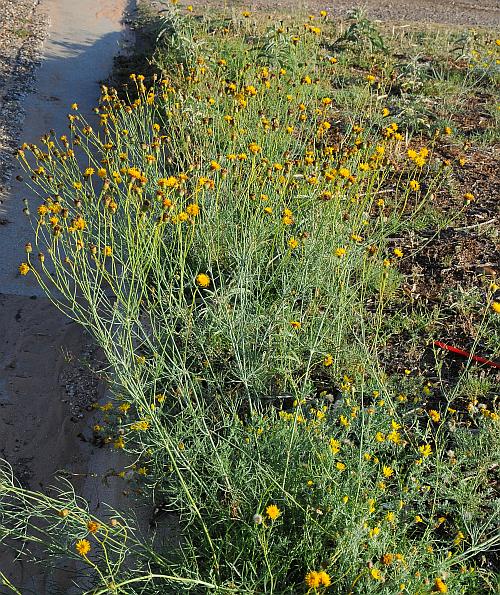Thelesperma megapotamicum (Spreng.) Kuntze
Colorado Greenthread

Introduced
CC = *
CW = 5
MOC = 2
© SRTurner
Thelesperma megapotamicum (Spreng.) KuntzeColorado Greenthread | |
 |
Introduced CC = * CW = 5 MOC = 2 |
© SRTurner |
|
Family - Asteraceae/Heliantheae Habit - Perennial forb with short, somewhat woody rhizomes.
Stem - Ascending to erect, to 80 cm, sometimes branched, glabrous or nearly so, somewhat glaucous.
Leaves - Opposite, pinnately dissected, short-petiolate to nearly sessile, sometimes crowded below the stem midpoint. Blades 3-12 cm long, all but occasionally those of the uppermost leaves 1 or less commonly 2 times pinnately dissected, the ultimate segments narrowly linear or filiform, 5-50 mm long.
Inflorescences - Solitary terminal heads on long, bractless stalks. Heads - Discoid. Involucre cup-shaped, the bracts in 2 dissimilar overlapping series, the outer series of 3-6 bracts 1-3 mm long, lanceolate to oblong or ovate; the inner series 7-10 mm long, fused in the basal 1/3-2/3, the free portion narrowly ovate to ovate-triangular. Receptacle flat or slightly convex, chaffy.
Florets - Ray florets absent. Disc florets perfect, the corollas 7-9 mm long, 5-lobed, yellow to orangish yellow, usually with reddish brown veins. Pappus absent or of 2 short, stout awns 1-3 mm long.
Fruits - Achenes 5-8 mm long, sometimes dissimilar in the same head, glabrous, brown or black. Flowering - May - July. Habitat - Railroads, open disturbed areas. Origin - Native to the U.S., considered introduced in Missouri. Lookalikes - None close. Other info. - This species is rare in Missouri, occurring infrequently as a hitchhiker on trains inbound from western regions. Its natural range lies almost entirely in the Great Plains, extending into the southwest. It is quite common within its range. Its threadlike dissected leaves, single heads on long, wiry stalks, and strange involucres make it hard to mistake for anything else. Although lacking ray florets, the heads are relatively showy, with numerous, relatively large disk florets. The dimorphic involucral bracts are reminiscent of those in Coreopsis, with those of Thelesperma differing by having the inner series of bracts fused at their bases. Photographs taken along roadsides in Brownfield, Terry County, Texas, 5-19-2016, near Ft. Laramie, Goshen County, WY, 8-13-2019, and at the Leopold Vista, Catron County, NM, 5-29-2023 (SRTurner). |